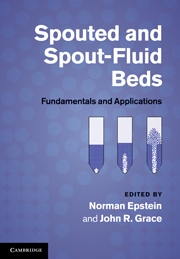Book contents
- Frontmatter
- Contents
- Contributors
- Preface
- Common nomenclature
- 1 Introduction
- 2 Initiation of spouting
- 3 Empirical and analytical hydrodynamics
- 4 Computational fluid dynamic modeling of spouted beds
- 5 Conical spouted beds
- 6 Hydrodynamics of spout-fluid beds
- 7 Spouted and spout-fluid beds with draft tubes
- 8 Particle mixing and segregation
- 9 Heat and mass transfer
- 10 Powder–particle spouted beds
- 11 Drying of particulate solids
- 12 Drying of solutions, slurries, and pastes
- 13 Granulation and particle coating
- 14 The Wurster coater
- 15 Gasification, pyrolysis, and combustion
- 16 Spouted bed electrochemical reactors
- 17 Scaleup, slot-rectangular, and multiple spouting
- 18 Mechanical spouting
- 19 Catalytic reactors and their modeling
- 20 Liquid and liquid–gas spouting of solids
- Index
- References
20 - Liquid and liquid–gas spouting of solids
Published online by Cambridge University Press: 04 February 2011
- Frontmatter
- Contents
- Contributors
- Preface
- Common nomenclature
- 1 Introduction
- 2 Initiation of spouting
- 3 Empirical and analytical hydrodynamics
- 4 Computational fluid dynamic modeling of spouted beds
- 5 Conical spouted beds
- 6 Hydrodynamics of spout-fluid beds
- 7 Spouted and spout-fluid beds with draft tubes
- 8 Particle mixing and segregation
- 9 Heat and mass transfer
- 10 Powder–particle spouted beds
- 11 Drying of particulate solids
- 12 Drying of solutions, slurries, and pastes
- 13 Granulation and particle coating
- 14 The Wurster coater
- 15 Gasification, pyrolysis, and combustion
- 16 Spouted bed electrochemical reactors
- 17 Scaleup, slot-rectangular, and multiple spouting
- 18 Mechanical spouting
- 19 Catalytic reactors and their modeling
- 20 Liquid and liquid–gas spouting of solids
- Index
- References
Summary
The spouted bed technique permits agitation of particles too coarse for fluidizing with a gas when excellent heat and mass transfer characteristics and intimate fluid–particle contacting are important. Liquid spouting has attracted much less interest, as coarse particles can be easily fluidized in this medium. However, recent advances in biotechnology and renewed interest in wastewater treatment have sparked new applications of liquid-spouted beds, particularly those incorporating a gas phase.
Liquid spouting
As discussed elsewhere in this book, a spouted bed can form when a fluid jet blows vertically upward along the center line of a vertical column, forming a spout in which fast-moving fluid and entrained particle mixing occur, surrounded by an annular region densely packed with particles moving slowly downward and inward. The spout is topped by a spillover fountain. Fluid percolates through the annulus from the spout. In a spout-fluid bed (see Chapter 6), additional fluid is introduced at the bottom of the annulus. Several fluid–particle patterns are possible, depending on the magnitude of the external annular fluid introduced to the annulus bottom:
(1) Spouting with irrigation: beds in which the external annular fluid velocity, Ua0, is restricted to a velocity that keeps the annular velocity UaH ≤ Umf.
(2) Spout-fluidization: beds in which the annulus is partly or completely fluidized; the level at which fluid velocity reaches Umf depends on the external annular flowrate. If Ua0 = Umf, the annulus is completely fluidized.
(3) Jet-fluidized beds: beds in which the bed depth is deeper than the maximum spoutable bed height. When the fluid is a liquid, such beds exhibit two zones: a lower spouted bed region and an upper fluidized bed zone.
- Type
- Chapter
- Information
- Spouted and Spout-Fluid BedsFundamentals and Applications, pp. 321 - 336Publisher: Cambridge University PressPrint publication year: 2010

